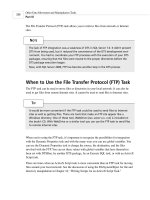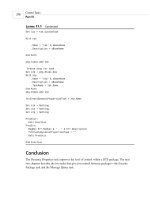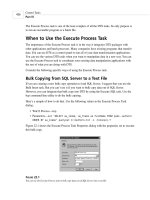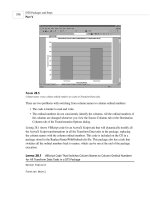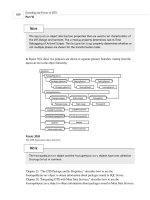Microsoft SQL Server 2000 Weekend Crash Course docx
Bạn đang xem bản rút gọn của tài liệu. Xem và tải ngay bản đầy đủ của tài liệu tại đây (4.27 MB, 409 trang )
WEEKEND CRASH COURSE
WEEKEND CRASH COURSE
™
KRIEGEL
MICROSOFT
®
SQL
SERVER 2000
ALEX
KRIEGEL,
MCSD
2 CD-ROMs
with a SQL Server
2000 trial, an
assessment test,
and more
30 Sessions
That Will Have
You Up and
Running with
SQL Server 2000
in Only 15 Hours
MICROSOFT
®
SQL SERVER 2000
HOUR
15
15
he big day is Monday. The day you get to show off what you know
about SQL Server 2000. The problem is, you’re not really up to speed.
Maybe it’s been a while since you worked with SQL Server. Or maybe
you just like a challenge. In any event, we’ve got a solution for you —
Microsoft SQL Server 2000 Weekend Crash Course. Open the book Friday
evening and on Sunday afternoon, after completing 30 fast, focused
sessions, you’ll be able to get right to work on a SQL Server 2000 database.
It’s as simple as that.
The Curriculum
Get Up to Speed on
SQL Server 2000 —
in a Weekend!
Get Up to Speed on
SQL Server 2000 —
in a Weekend!
2 CD-ROMS INCLUDE:
• SQL Server 2000 120-
day Evaluation Edition
• SQL Programmer trial
version
• Evaluation versions
of database utilities,
including Rapid SQL,
DB Artisan, and
ER/Studio
• Web links to useful
SQL Server sites
• Sample code and
scripts
• Assessment software
System Requirements:
PC with Pentium 133 or higher;
Windows 2000 Server: 128MB
RAM. See the About the CD
Appendix for details and
complete system requirements.
Category:
Database
WEEKEND CRASH COURSE
WEEKEND CRASH COURSE
T
™
ISBN 0-7645-4840-9
,!7IA7G4-feieag!:p;M;t;t;T
FRIDAY
Evening: 4 Sessions, 2 Hours
• Microsoft SQL Server 2000:
Getting Started
• Go Configure: After
Installation
• First Look at Enterprise
Manager Console
• Second Look at Enterprise
Manager Console
SATURDAY
Morning: 6 Sessions, 3 Hours
• Relational Database
Concepts
• SQL Server System
Databases
• Creating and Using a
Custom Database
• Transact-SQL Programming
• SQL Query Analyzer
• More Transact-SQL
Programming
SATURDAY, continued
Afternoon: 6 Sessions, 3 Hours
• Creating and Using Stored
Procedures and Triggers
• OSQL and ISQL
• Introducing Cursors
• Understanding
Transactions
• Locking
• Rules, Defaults, and
Constraints
Evening: 4 Sessions, 2 Hours
• Data Transformation
• SQL Server Back Up
• Server Replication
• User Management
SUNDAY
Morning: 6 Sessions, 3 Hours
• Managing Your Databases
— Visually
• Microsoft Distributed
Transaction Coordinator
• System Functions and
Stored Procedures
• Automating
Administration Tasks with
SQL Server Agent
• SQL Mail Agent
• Performance Tuning and
Optimization
Afternoon: 4 Sessions, 2 Hours
• Disaster Recovery
• SQL Server Security
• Database Connectivity
• Advanced Features of
SQL Server 2000
WEEKEND
CRASH
COURSE
HOURS
*85555-AIGGHi
For more information on
Hungry Minds, go to
www.hungryminds.com
$29.99 US
$44.99 CAN
£24.99 UK incl. VAT
4840-9 cover 8/20/01 9:17 AM Page 1
Microsoft
®
SQL Server 2000
Weekend Crash Course
014840-9 FM.F 8/28/01 12:51 PM Page i
014840-9 FM.F 8/28/01 12:51 PM Page ii
Microsoft
®
SQL Server 2000
Weekend Crash Course
™
Alex Kriegel
Best-Selling Books • Digital Downloads • e-Books • Answer Networks
e-Newsletters • Branded Web Sites • e-Learning
New York, NY • Cleveland, OH • Indianapolis, IN
014840-9 FM.F 8/28/01 12:51 PM Page iii
Microsoft
®
SQL Server 2000 Weekend Crash
Course
™
Published by
Hungry Minds, Inc.
909 Third Avenue
New York, NY 10022
www.hungryminds.com
Copyright © 2001 Hungry Minds, Inc. All rights
reserved. No part of this book, including interior
design, cover design, and icons, may be reproduce-
dor transmitted in any form, by any means (elec-
tronic, photocopying, recording, or otherwise)
without the prior written permission of the
publisher.
Library of Congress Control 2001089349
ISBN: 0-7645-4840-9
Printed in the United States of America
10 9 8 7 6 5 4 3 2 1
1B/RW/QZ/QR/IN
Distributed in the United States by Hungry Minds,
Inc.
Distributed by CDG Books Canada Inc. for Canada;
by Transworld Publishers Limited in the United
Kingdom; by IDG Norge Books for Norway; by IDG
Sweden Books for Sweden; by IDG Books Australia
Publishing Corporation Pty. Ltd. for Australia and
New Zealand; by TransQuest Publishers Pte Ltd. for
Singapore, Malaysia, Thailand, Indonesia, and Hong
Kong; by Gotop Information Inc. for Taiwan; by ICG
Muse, Inc. for Japan; by Intersoft for South Africa;
by Eyrolles for France; by International Thomson
Publishing for Germany, Austria, and Switzerland;
by Distribuidora Cuspide for Argentina; by LR
International for Brazil; by Galileo Libros for Chile;
by Ediciones ZETA S.C.R. Ltda. for Peru; by WS
Computer Publishing Corporation, Inc., for the
Philippines; by Contemporanea de Ediciones for
Venezuela; by Express Computer Distributors for
the Caribbean and West Indies; by Micronesia Media
Distributor, Inc. for Micronesia; by Chips
Computadoras S.A. de C.V. for Mexico; by Editorial
Norma de Panama S.A. for Panama; by American
Bookshops for Finland.
For general information on Hungry Minds’ products
and services please contact our Customer Care
department within the U.S. at 800-762-2974, out-
side the U.S. at 317-572-3993 or fax 317-572-4002.
For sales inquiries and reseller information, includ-
ing discounts, premium and bulk quantity sales,
and foreign-language translations, please contact
our Customer Care department at 800-434-3422,
fax 317-572-4002 or write to Hungry Minds, Inc.,
Attn: Customer Care Department, 10475 Crosspoint
Boulevard, Indianapolis, IN 46256.
For information on licensing foreign or domestic
rights, please contact our Sub-Rights Customer Care
department at 212-884-5000.
For information on using Hungry Minds’ products
and services in the classroom or for ordering exam-
ination copies, please contact our Educational Sales
department at 800-434-2086 or fax 317-572-4005.
For press review copies, author interviews, or other
publicity information, please contact our Public
Relations department at 317-572-3168 or fax 317-
572-4168.
For authorization to photocopy items for corporate, personal, or educational use, please contact
Copyright Clearance Center, 222 Rosewood Drive, Danvers, MA 01923, or fax 978-750-4470.
LIMIT OF LIABILITY/DISCLAIMER OF WARRANTY: THE PUBLISHER AND AUTHOR HAVE USED THEIR
BEST EFFORTS IN PREPARING THIS BOOK. THE PUBLISHER AND AUTHOR MAKE NO REPRESENTA-
TIONS OR WARRANTIES WITH RESPECT TO THE ACCURACY OR COMPLETENESS OF THE CONTENTS
OF THIS BOOK AND SPECIFICALLY DISCLAIM ANY IMPLIED WARRANTIES OF MERCHANTABILITY OR
FITNESS FOR A PARTICULAR PURPOSE. THERE ARE NO WARRANTIES WHICH EXTEND BEYOND THE
DESCRIPTIONS CONTAINED IN THIS PARAGRAPH. NO WARRANTY MAY BE CREATED OR EXTENDED
BY SALES REPRESENTATIVES OR WRITTEN SALES MATERIALS. THE ACCURACY AND COMPLETENESS
OF THE INFORMATION PROVIDED HEREIN AND THE OPINIONS STATED HEREIN ARE NOT GUARAN-
TEED OR WARRANTED TO PRODUCE ANY PARTICULAR RESULTS, AND THE ADVICE AND STRATEGIES
CONTAINED HEREIN MAY NOT BE SUITABLE FOR EVERY INDIVIDUAL. NEITHER THE PUBLISHER
NOR AUTHOR SHALL BE LIABLE FOR ANY LOSS OF PROFIT OR ANY OTHER COMMERCIAL DAMAGES,
INCLUDING BUT NOT LIMITED TO SPECIAL, INCIDENTAL, CONSEQUENTIAL, OR OTHER DAMAGES.
Trademarks: Weekend Crash Course is a trademark or registered trademark of Hungry Minds, Inc.
Microsoft is a registered trademark or trademark of Microsoft Corporation. All other trademarks are prop-
erty of their respective owners. Hungry Minds, Inc. is not associated with any product or vendor men-
tioned in this book.
014840-9 FM.F 8/28/01 12:51 PM Page iv
About the Author
Alex Kriegel, MCSD, has worked for Psion Teklogix International Inc., Integration Services
Group for the past three years. Their main product is TekRF Integration Components for
SAP R/3. Alex participated in designing and implementing it from the very beginning back
in 1997. In addition to programming, he is also responsible for troubleshooting SQL Server
installations, optimizing performance, and devising SQL stored procedures and such. For the
past two years Alex has taught a course on SQL/SQL Server for a group of SAP analysts.
Acquisitions Editor
Terri Varveris
Project Editor
Valerie Perry
Technical Editors
Allen Wyatt and Trevor Dwyer
Copy Editor
S.B. Kleinman
Project Coordinator
Dale White
Graphics and Production Specialists
Joyce Haughey
Adam Mancilla
Betty Schulte
Brian Torwelle
Quality Control Technicians
Laura Albert
Susan Moritz
Angel Perez
Charles Spencer
Permissions Editor
Laura Moss
Media Development Specialist
Travis Silvers
Media Development Coordinator
Marisa Pearman
Proofreading and Indexing
TECHBOOKS Production Services
Credits
014840-9 FM.F 8/28/01 12:51 PM Page v
I dedicate this book to my teacher in a previous life,
Dr. Isaac I. Garbar, for everything I did not have time to
accomplish in the physics of wear and friction of metals
while I was taking my time to explore Zen teachings.
014840-9 FM.F 8/28/01 12:51 PM Page vi
S
QL Server 2000 is a major milestone for Microsoft, which is trying to position
itself as a significant player in the database market. The demand for database-
driven sites on the Internet is exploding (some major sites are running SQL
Server 2000 as their back end, Microsoft included), creating a demand for qualified
people who understand the product — from technical support people to analysts to
programmers without database experience.
With so many SQL Server books on the market you may wonder why there is any
need for another one. There is more than one way to tell a story, and I like to
think that this book offers a special angle from which to approach the rather com-
plex topic of Relational Database Management Systems in general and SQL Server
2000 in particular.
I intend for this book to provide a no-nonsense, hands-on introduction to SQL
Server for the widest audience possible: technical-support people whose company
product includes SQL Server as part of its solution, small companies’ “jacks of all
trades” doing in-house maintenance, beginning and intermediate programmers
breaking into the field or switching careers or upgrading from some other database
system, managers who would like to know what SQL Server can do for them with-
out getting involved in a “holy war” of database vendors — and so on.
Who Should Read this Book
This crash course is comprised of a set of short lessons that you can grasp quickly —
in one weekend. While writing this book I kept two kinds of people in mind:
Those who need to learn SQL Server 2000 fast and do not know where to
start. These people have just the right mix of basic technical knowledge
and curiosity, and need to feel comfortable using SQL Server.
Those who worked with previous versions of SQL Server and would like a
brief, hands-on introduction to SQL Server 2000 — one basic enough for
beginners, but deep enough for intermediate users.
Preface
014840-9 FM.F 8/28/01 12:51 PM Page vii
What You Need to Have
In order to make the most of this book, you’ll need the following:
¼
A computer (Pentium 166 or higher) running Windows NT 4.0 Server or
Windows 2000 Server.
¼
Microsoft SQL Server 2000 Standard Edition installation.
¼
Lots of patience and the desire to find out what SQL Server 2000 is all about.
You can get by with most of the material in this book using Windows 98 and
the Personal Edition of SQL Server 2000, though this could not be considered
“making the most of it.”
What Results Can You Expect?
Can you become a SQL Server database administrator in a weekend? As much as I
would like to say the opposite, the answer is no. It takes much more than just
three days of studying to become a database administrator. Can you become a com-
petent user of SQL Server, and gain an understanding of some of the finer points of
SQL Server 2000 features, in a weekend? Absolutely.
This is not a reference book and it does not pretend to cover each and every
aspect of SQL Server in depth. It will help you to get up and runningand, at the
same time, show you where to look for further information.
You can expect to learn how to set up SQL Server 2000 with most standard fea-
tures (and troubleshoot the installation if anything goes wrong). I will provide a
thorough introduction to the most important SQL Server features and objects —
SQL Server administration, creating and destroying database objects, optimizing
performance, publishing information on the Internet, and much more — and to
using them for your own purposes.
Layout and Features
This book follows the standard Weekend Crash Course layout and includes the stan-
dard features of the series so that you can be assured of mastering basic SQL
Server 2000 skills within a weekend — 30 hours, to be precise. The book contains
30 sessions, each about one hour long, to be read over the course of three and a
half days. At the end of each session you’ll find “Quiz Yourself” questions, and at
Prefaceviii
014840-9 FM.F 8/28/01 12:51 PM Page viii
the end of each part you’ll find Part Review questions. These questions enable you
to test your knowledge and exercise your newly acquired skills. (The answers to
the part-review questions are in Appendix A.)
Layout
This Weekend Crash Course contains 30 one-hour sessions organized into six parts.
Each part corresponds to a time during the weekend, as outlined in the following
sections.
Part I: Friday evening
This is the “get started” part. You will go through the complete process of setting
up SQL Server 2000, starting from hardware and software considerations to select-
ing installation options to having an up-and-running instance of SQL Server. You
will go through the process of installing and configuring your server and will also
get a glimpse of what lies ahead.
Part II: Saturday morning
In this part you will get into the fundamental concepts of relational databases,
both examining SQL Server system databases and getting an introduction to creat-
ing and using user databases. You also will get an introduction to Structured Query
Language (SQL), the language of relational databases.
Part III: Saturday afternoon
In these sessions you will take your SQL Server 2000 programming skills to a new
level: You will be introduced to stored procedures, triggers, and cursors. The ses-
sion on indices will give you a thorough understanding of this important concept.
This part also includes in-depth discussions of locking, transactions, and the
integrity mechanisms of SQL Server 2000.
Part IV: Saturday evening
This part will introduce you to some advanced features of SQL Server such as Data
Transformation Services, backing up and restoring, and replication. It also will
cover the basics of user management in the context of SQL Server 2000.
Preface ix
014840-9 FM.F 8/28/01 12:51 PM Page ix
Part V: Sunday morning
Here you will be introduced to database-management issues. You will learn about
distributed transactions, obtaining system information, and automating adminis-
trative tasks with SQL Server Agent. The sections in this part will show you how to
configure SQL Server to send and receive e-mail. You will also learn how to opti-
mize and tune the performance of SQL Server.
Part VI: Sunday afternoon
In this part you will learn about disaster recovery and receive a comprehensive
introduction to SQL Server 2000 security. The sessions in this part will also address
connectivity issues and give an overview of the most advanced features in SQL
Server 2000.
Features
As you go through each session, look for the following icons that let you know
how much progress you’ve made in the session:
Remember, these are just suggestions: You may need more or less time to finish
the section. The book also contains other icons that call your attention to special
points of interest:
These alert you to important pieces of information that you
should file away in your head for later.
These give you helpful advice about the best ways to do things,
or tell you about a tricky technique that can make your HTML
programming go more smoothly.
These tell you where you can find related material in other
sessions.
Cross-Ref
Tip
Note
Prefacex
014840-9 FM.F 8/28/01 12:51 PM Page x
Accompanying CD-ROM
You will find a CD-ROM at the back of this book. It contains a skills-assessment
test, a PDF version of the book, and as many useful tools and as much information
as it is possible to fit there. For a complete description of each item on the
CD-ROM, see Appendix B.
Reach Out
I know this book could have been better given enough time and space (uh . . .
about five more years to write and 5,000 pages to hold the information). Neither
you nor I have this luxury. Any feedback that will help to make revised editions of
this book better and more comprehensive will be appreciated. Send your comments
about the content of this book to:
As the saying goes, all you know today is obsolete. With this cheerful thought,
you are ready to plunge into the relational database world — through the SQL
Server 2000 entrance.
Preface xi
014840-9 FM.F 8/28/01 12:51 PM Page xi
014840-9 FM.F 8/28/01 12:51 PM Page xii
M
y gratitude goes to Grace M. Buechlein, who introduced me to the world of
book-writing and convinced me that I could do it. Thank you very much,
Grace!
I thank with all my heart my Development/Project Editor Valerie Perry, who
taught me how to be eloquent without sacrificing technical details along the way,
and who helped me with every step — all in spite of power shortages in California.
I really appreciate your help.
I am very grateful to my acquisitions editor, Terri Varveris, who pressed me hard
to meet deadlines, and who encouraged me and guided me with extreme patience
through all the intricacies of writing a technical book. Thank you, Terri!
I am very grateful to my copy editor, S. B. Kleinman, for all the work she did to
make the original text better, a lot better.
I would like to express my gratitude to my technical editor, Allen Wyatt, for
actually reading through these pages, picking out inconsistencies, bloopers, and
outright errors, and making valuable suggestions about how to improve the con-
tent of the book, chapter by chapter. My thanks also go to Trevor Dwyer, my other
technical editor who helped edit the first several chapters of this book.
This book would have been impossible without the meticulous work of the
Hungry Minds team that helped me to get everything in shape: Kyle Looper, Laura
Moss, Marissa Pearman, Nancy Maragioglio and Dale White. Thank you.
My thanks also go to Bradley Ruste, my colleague, for helping me to write the
chapter on SQL Server 2000 backup, as well as the general discussions of the SQL
Server topics we’re having from time to time.
I thank my parents, Lazar and Raisa Kriegel, for their lifelong understanding
and support, sometimes even against their best judgment.
My deepest gratitude goes to my wife, Liana, for her support when I needed it
most, and to my two sons, Phillip and Michael, for giving me endless hours of fun
as I explained to them the finer points of relational-database systems, and being
there for me when I needed them. Thank you.
Acknowledgments
014840-9 FM.F 8/28/01 12:51 PM Page xiii
Preface vii
Acknowledgments xiii
FRIDAY 2
Part I—Friday Evening 4
Session 1–Getting Started 5
Session 2–Go Configure 19
Session 3–First Look at Enterprise Manager Console 29
Session 4–Second Look at Enterprise Manager Console 37
SATURDAY 48
Part II—Saturday Morning 50
Session 5–Relational Database Concepts 51
Session 6–SQL Server Databases 61
Session 7–Creating and Using a Custom Database 73
Session 8–Transact-SQL Programming Language 81
Session 9–T-SQL and SQL Query Analyzer 95
Session 10–Programming with T-SQL 107
Part III—Saturday Afternoon 124
Session 11–Creating and Using Stored Procedures 125
Session 12–Trigger Happy 137
Session 13–Introducing Cursors 145
Session 14–Understanding Indexes 155
Session 15–Rules, Defaults, and Constraints 167
Session 16–Understanding Transactions and Locks 177
Part IV—Saturday Evening 190
Session 17–Data Transformation Services 191
Session 18–SQL Server Back Up 201
Session 19–SQL Server Replication 213
Session 20–User Management 225
SUNDAY 238
Part V—Sunday Morning 240
Session 21–Managing Your Databases Visually 241
Session 22–Distributed Transaction Coordinator 251
Session 23–Accessing SQL Server System Information 263
Contents at a Glance
014840-9 FM.F 8/28/01 12:51 PM Page xiv
Session 24–Automating Administration Tasks with SQL Server Agent 273
Session 25–Configuring SQL Server Mail 283
Session 26–Performance Tuning and Optimization 293
Part VI—Sunday Afternoon 308
Session 27–Disaster Recovery 309
Session 28–SQL Server Security 319
Session 29–Database Connectivity 331
Session 30–Advanced Features of Microsoft SQL Server 2000 341
Appendix A–Answers to Part Reviews 355
Appendix B–What’s on the CD-ROM? 367
Index 371
014840-9 FM.F 8/28/01 12:51 PM Page xv
014840-9 FM.F 8/28/01 12:51 PM Page xvi
Preface vii
Acknowledgments xiii
FRIDAY 2
Part I—Friday Evening 4
Session 1–Getting Started 5
Understanding Microsoft SQL Server 5
Installing SQL Server 2000 6
System requirements 7
Before you begin the installation 8
Stepping through the installation 9
Completing the installation and rebooting your computer 17
Session 2–Go Configure 19
Fixing a Faulty Installation 20
Running SQL Server Service Manager 20
Managing Configuration Tasks 22
Windows NT 22
Windows 2000 23
Locating SQL Server Files 23
Adding Components 25
Uninstalling SQL Server 25
Session 3–First Look at Enterprise Manager Console 29
Starting the Enterprise Manager 29
Creating Server Groups and Registering Servers 31
Down Under: Inspecting Registered SQL Server Nodes 33
Considering Your Options 34
Accessing SQL Server Books Online 36
Session 4–Second Look at Enterprise Manager Console 37
Meeting the Wizards 37
Database administration wizards 39
Database wizards 40
The Replication Wizard 41
The Web Assistant Wizard 41
Running Command-Line Utilities 42
Understanding Data Transformation Services 44
Accessing SQL Server Agent 45
Contents
014840-9 FM.F 8/28/01 12:51 PM Page xvii
SATURDAY 48
Part II—Saturday Morning 50
Session 5–Relational Database Concepts 51
Identifying the Limitations of Spreadsheet Programs 51
Understanding Legacy Database Models 52
Hierarchical databases 52
Network databases 54
Introducing the Relational Database Model 54
Many-to-many relationships 55
One-to-many relationships 56
One-to-one relationships 56
Exploring Relational-Database Management-System Implementations 56
Learning Relational-Database Terminology 58
Session 6–SQL Server Databases 61
Understanding the SQL Server System Databases 61
The Master database 62
The TempDB database 62
The Model database 63
The MSDB database 63
Exploring the SQL Server Sample Databases 64
The Pubs database 64
The Northwind database 65
Learning the Basics of Relational Database Design 65
Get normal 68
Common pitfalls of database design 70
Flat-file design 70
Spreadsheet design 70
Design tied to a particular RDBMS implementation 70
Session 7–Creating and Using a Custom Database 73
Creating a New Database in SQL Server 2000 73
Modifying Database and Transaction Log Properties 77
Deleting a Database 79
Session 8–Transact-SQL Programming Language 81
Learning about Transact SQL 81
Using the SELECT Keyword 82
Working with the JOIN and UNION Keywords 87
The JOIN keyword 87
The UNION keyword 90
Using the INSERT, UPDATE, and DELETE Keywords 90
Using the INSERT keyword 90
Using the UPDATE keyword 91
Using the DELETE keyword 92
Knowing about Additional T-SQL Keywords and Functions 93
Contentsxviii
014840-9 FM.F 8/28/01 12:51 PM Page xviii
Session 9–T-SQL and SQL Query Analyzer 95
Learning about T-SQL and SQL Query Analyzer 95
Creating, Altering, and Dropping Databases with T-SQL 98
Creating databases 98
Altering databases 99
Dropping databases 100
Creating, Altering, and Dropping Tables with T-SQL 100
Creating tables 100
Altering tables 101
Deleting tables 102
Getting Information about Your SQL Server 102
Working with the Query Analyzer Templates and the Object Browser 103
Session 10–Programming with T-SQL 107
Declaring and Using T-SQL Variables 107
Implicit conversion 109
Explicit conversion 110
Using Control-of-Flow Statements 111
Exploring T-SQL Operators 113
Arithmetic operators 114
Comparison operators 114
Logical operators 115
The assignment operator 116
The string concatenation operator 116
Unary operators 116
Operator precedence 117
Working with Aggregate Functions 118
Running Subqueries 118
Using the CASE Function 119
Part III—Saturday Afternoon 124
Session 11–Creating and Using Stored Procedures 125
Creating Stored Procedures 125
Commenting Transact-SQL Code 128
Error Handling 129
Using Different Types of Stored Procedures 132
Temporary stored procedures 132
Nested and recursive stored procedures 133
System stored procedures 134
Renaming and Dropping a Stored Procedure 134
Session 12–Trigger Happy 137
Introducing Triggers 137
AFTER triggers 139
INSTEAD OF triggers 141
Contents xix
014840-9 FM.F 8/28/01 12:51 PM Page xix
Recursive triggers 142
Nested triggers 142
Managing Triggers 143
Creating triggers 143
Dropping (deleting) triggers 143
Modifying triggers 144
Session 13–Introducing Cursors 145
Understanding Cursors 145
Using Different Types of Cursors 148
Scrollable cursors 148
Static cursors 149
Dynamic cursors 149
Keyset cursors 150
Forward-only cursors 150
Understanding the Scope of the Cursors 150
Setting Cursor Concurrency Options 151
Choosing the Right Cursor 152
Session 14–Understanding Indexes 155
Using Indexes 155
Clustered indexes 156
Non-clustered indexes 157
Designing an Index 157
Creating and Deleting an Index 158
Managing an Index 164
Session 15–Rules, Defaults, and Constraints 167
Enforcing Data Integrity 167
Types of integrity 168
Types of constraints 168
PRIMARY KEY constraints 168
FOREIGN KEY constraints 169
UNIQUE constraints 170
CHECK constraints 171
RULE constraints 172
DEFAULT constraints 173
Understanding NULL Values 175
Session 16–Understanding Transactions and Locks 177
Understanding Transactions 177
Explicit and implicit transactions 180
Distributed transactions 181
Setting Isolation Levels 182
Introducing SQL Server Locks 183
Exploring Lock Types 184
Dealing with Deadlocks 185
Contentsxx
014840-9 FM.F 8/28/01 12:51 PM Page xx
Part IV—Saturday Evening 190
Session 17–Data Transformation Services 191
Introducing Data Transformation Services 191
Importing and Exporting Data through DTS 192
Maintaining DTS Packages 197
Using the Bulk Copy Command-Line Utility 198
Session 18–SQL Server Back Up 201
Implementing Backup and Recovery Planning 201
Using Different Backup Strategies 202
Complete database backups 203
Differential backup 207
Transaction-log backup 207
Selecting a Recovery Mode 207
Simple recovery 208
Full recovery 208
Bulk-logged recovery 208
Restoring a Database 208
Managing Backups 211
Session 19–SQL Server Replication 213
Reviewing SQL Server Replication 213
Basic replication terminology 214
Selecting a Replication Model 216
Preparing for Replication 216
Snapshot replication 217
Transactional replication 217
Merge replication 217
Setting up Replication 217
Creating publications 220
Managing subscriptions 222
Monitoring replication 223
Session 20–User Management 225
Setting Up a User Account 225
Roles 226
Logins 226
Managing User Permissions 230
Managing a Multiuser Environment 233
SUNDAY 238
Part V—Sunday Morning 240
Session 21–Managing Your Databases Visually 241
Devising a Database-Maintenance Plan 241
Scripting and Documenting Your Database 247
Moving and Copying Database Files 248
Contents xxi
014840-9 FM.F 8/28/01 12:51 PM Page xxi
Session 22–Distributed Transaction Coordinator 251
Using Remote Servers and Linked Servers 251
Remote servers 252
Linked servers 254
Accessing External Data Sources 258
Using Microsoft Distributed Transaction Coordinator (MSDTC) 259
Session 23–Accessing SQL Server System Information 263
Obtaining SQL Server System Information 263
Using Information Schema Views 264
Using System Stored Procedures 266
General stored procedures 267
Catalog stored procedures 267
Security stored procedures 268
SQL Server Agent stored procedures 269
Extended stored procedures 269
Session 24–Automating Administration Tasks with SQL Server Agent 273
Configuring and Using SQL Server Agent 273
Configuration screen 274
Properties 274
The Alert tab 275
The Jobs tab 275
The Connection tab 275
Scheduling Jobs 276
Creating Alerts 278
Managing Operators 280
Administering Multiple Servers 281
Session 25–Configuring SQL Server Mail 283
Setting Up Your Mail Profile 283
Configuring SQL Mail and SQL Server Agent Mail 286
Sending Mail through Extended Stored Procedures 288
Troubleshooting 289
Session 26–Performance Tuning and Optimization 293
Monitoring and Profiling 293
Tuning SQL Queries 296
Using the Index Tuning Wizard 299
Optimizing TempDB and the Transaction Log 301
Optimizing TempDB performance 301
Optimizing Transaction Log performance 302
Using Database Consistency Check (DBCC) 302
Contentsxxii
014840-9 FM.F 8/28/01 12:51 PM Page xxii
Part VI—Sunday Afternoon 308
Session 27–Disaster Recovery 309
Planning for Disaster 309
Identifying Basic Disaster Scenarios 310
Physical destruction 311
Failed operating system 311
Database corruption 311
Verifying functionality 312
Creating Standby Servers 312
Managing the Disaster 313
Session 28–SQL Server Security 319
Planning for Security 319
Introducing SQL Server Authentication Modes 320
Configuring SQL Server Roles 321
Fixed server roles 322
Adding a member to a fixed server role 322
Database roles 323
Adding a member to a database role 324
Application roles 326
Using Views as a Security Mechanism 327
Understanding SQL Server File Permissions 328
Auditing SQL Server 328
Session 29–Database Connectivity 331
Introducing DBLIB, ODBC and OLE DB 331
DBLIB 332
Open Database Connectivity (ODBC) 332
OLE DB 332
Configuring ODBC Data Sources 333
Presenting DAO, RDO, and ADO 337
Interoperability with Non-Windows Machines and the Internet 339
Session 30–Advanced Features of Microsoft SQL Server 2000 341
Using English Query 341
Performing Full-Text Searches 343
Using SQL Server 2000 Analytical Services 345
Running the Web Assistant Wizard 347
Getting SQL Server XML Support 349
Appendix A–Answers to Part Reviews 355
Appendix B–What’s on the CD-ROM?xxii 367
Index 371
Contents xxiii
014840-9 FM.F 8/28/01 12:51 PM Page xxiii
024840-9 DPO1.F 8/28/01 12:51 PM Page 2


